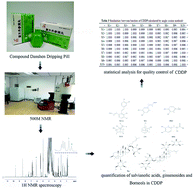Quantitative analysis of salvianolic acids, ginsenosides and borneols using 1H qNMR for quality control of compound Danshen dripping pills
Abstract
Compound Danshen Dripping Pills (CDDPs) are a Chinese herbal medicinal preparation composed of Salviae miltiorrhizae Radix and two other Chinese medicines, Notoginseng Radix and Borneolum. The main components of CDDPs are protocatechuic aldehyde, danshensu, salvianolic acid A, rosmarinic acid, ginsenoside Rg1, ginsenoside Rb1, L-(−)-borneol and isoborneol. The complex composition of CDDPs, which contains phenolic acids, ginseng saponins and borneols, makes quantitative analysis by traditional methods difficult. Therefore, a fast and accurate 1H qNMR method was established that can simultaneously determine the eight main components of CDDPs. The qNMR method was well validated and successfully applied in the determination of ten sample batches. The vector cosine angle method was used for further analysis of the results to evaluate the sample quality. The results indicate that the qNMR method is suitable for the quality control of CDDPs and has potential as an easy alternative for the analysis of other complex Traditional Chinese Medicines (TCMs) that require two or more traditional instruments for comprehensive quantitative analysis.



 Please wait while we load your content...
Please wait while we load your content...